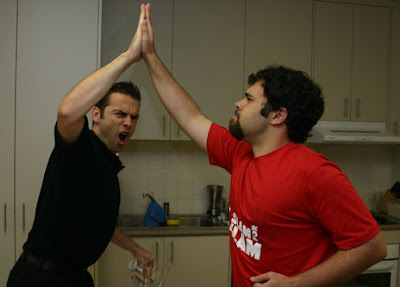 |
| Ross McMillan and Sarah Constible in Steve Ratzlaff's Dionysus in Stony Mountain (photo credit Leif Norman) |
Ross McMillan and
Sarah Constible are two mainstays of the Winnipeg theatre scene. They’re being
directed by Bill Kerr in Theatre Projects Manitoba’s upcoming production of 'Dionysus
in Stony Mountain’ by Steve Ratzlaff. I caught up with them (on behalf of The Uniter) having a
break at Elephant and Castle between rehearsals.
SC: Is it
recording right now (leans in to Android)
Hellloooooo?
BK: Do you know the British hen party
tradition? It’s like a stagette… what they do, Ryan Air flights are so cheap
that they spend like $150 to get to Dublin and they spend 48 hours getting
tricked there. So you see these mobs of drunken women throwing up and yelling
and fighting. And it’s another weekend in Dublin.
SC: Oh my god.
I’ve got to go to this place called Ireland.
SC: We were doing a line run the other day
and there was an old Winnipeg Sun sitting there and I started flipping through
it and there were two articles within two pages of each other about different
offenders from Stony... It seems like the Winnipeg Sun is filled with all these sensationalist
stories and I think the play we’re working on, a lot of it goes ‘Why is this
the society we’ve decided to embrace?’
MT: Does anyone
here have experience with the justice system?
RM: No!
SC: Twenty years.
Twenty years, yep. Killed that kid.
BK: My foster brother has been incarcerated a
number of times, though not here in Manitoba. So I’m fairly familiar with the
failure of the justice system as a place that 'certainly didn’t rehabilitate
him' let’s put it that way… it’s hardly a place of reform, yet somehow it’s
claimed to be.
SC: And Steve’s not only touching on the
justice system, he was a teacher in the regular education system too.
RM: I asked Steve what he was doing with this
play, after seeing its earliest draft. And he said ‘Well, I just want to take
some Nietzsche and shove it in the faces of the middle class just to see. Just
to go ‘how do you like that?’’ If you take the quite persuasive argument of one
of the main characters in the play, it really recommends that you don’t take
the weak members of society and revere them as victims. The implication left
hanging in the play is that you let them die… I think he wants to
provoke a discussion. That’s quite a piece of provoking, I’d say.
BK: We can get caught up in the sense that
nothing ever gets better. But there has actually been real change. Whatever
-ism you care to look at, like post colonialism – we were just talking about
Ireland – yeah, a lot of the problems are replicated but there is a country
there and there wasn’t before. Partitioned, but certain things have improved.
SC: I can now marry a black man…
BK: Yes, you can! Exactly. So there’s always a
ying and yang, but there is genuine change.
RM: Yes, true. But look at the States. Look at
all the social advances that started in the 60s: feminism and the civil rights
movement. A lot of people on the Right are now talking very openly about taking
these away, about rolling these back. These changes aren’t necessarily
permanent. And the British could invade Ireland again.
SC: Well the only reason they have a platform
is because of the Internet. Now we have this democratization of communication -
that’s the only reason these nutjobs are getting a chance to say their point of
view.
RM: Not necessarily. Look at the Republican nomination
race. These nutjobs are mainstream now.
SC: What? You’re saying Santorum is a nutjob?
What is your problem?
RM: He’s a fine man… He’s a good-looking man.
He gives me the horn.
BK: (laughing)
There’s the quote right there.
RM: And
he’s doing it on purpose!
RM: One of the most forcefully put point of
views in Dionysus in Stony Mountain
is not just critical of boot licking liberalism, but scornful of it. And not
just scornful of it, but pointing an accusatory finger of it being the
sentiment that is sickening our society. And that’s what he’s presenting to an
audience and asking them to consider.
That’s definitely not preaching to the choir.
SC: He’s going to
offend everybody-
BK: You mean intrigue!
SC: Intrigue -
that’s the word.
BK: It asks real
questions.
RM: And underneath all that, there’s grief.
There’s real grief that comes as a surprise. As perhaps it always does. That
after all the blaming and guilt and anger, sometimes what you find underneath
that is grief. Beyond which there’s not much to say… sometimes when you let
people give vent to what appears to be their most deeply held grievances and
beliefs - when they finally get it all out - underneath it is something as
simple as grief that can suddenly transfigure a person and make everything
they’ve been saying, not irrelevant…
SC: Enhanced?
RM: Enhanced, yes. But you can suddenly see
that underneath all the arguments and moral haggling, sometimes what really
needs to be recognized is simple pain. And real pain can’t be dealt with
institutionally; it can only dealt with between two people. And if you ever
experience that, you’re lucky.
Dionysus in Stony Mountain runs March 29 to April 8 - details and tickets here.
























